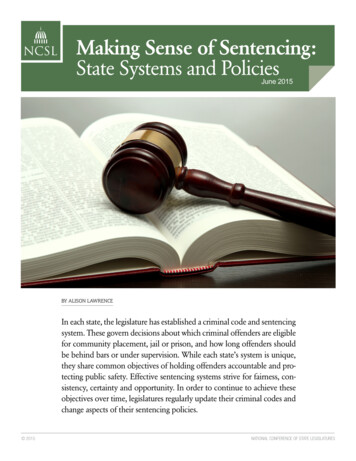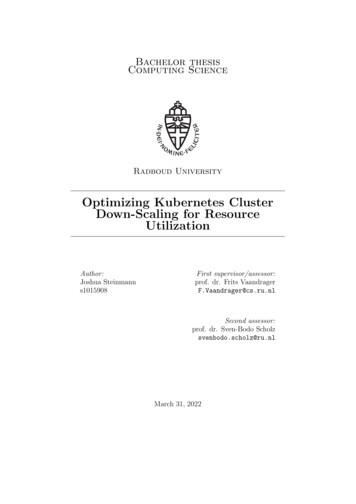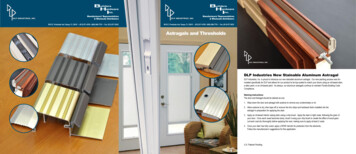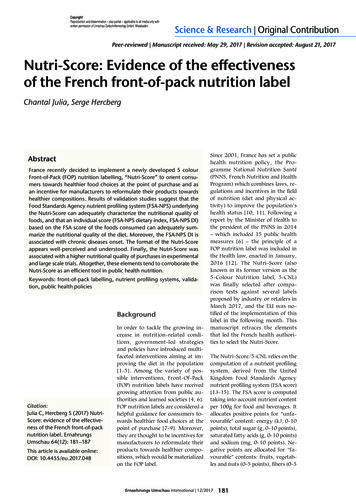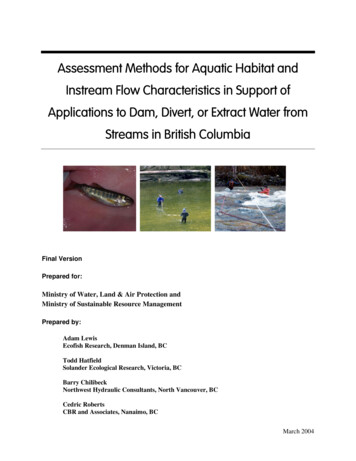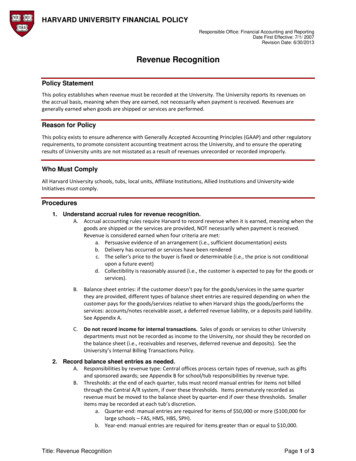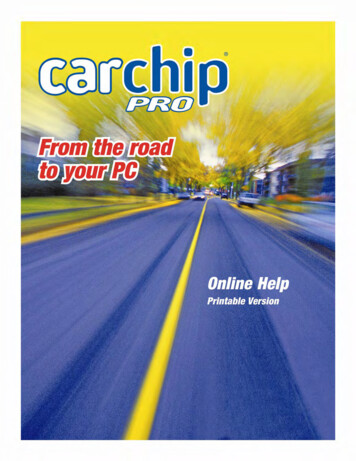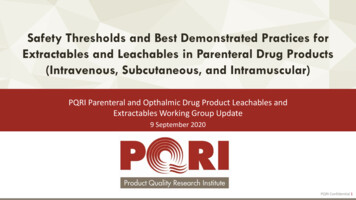
Transcription
Safety Thresholds and Best Demonstrated Practices forExtractables and Leachables in Parenteral Drug Products(Intravenous, Subcutaneous, and Intramuscular)PQRI Parenteral and Opthalmic Drug Product Leachables andExtractables Working Group Update9 September 2020PQRI Confidential 1
Product Quality Research Institute (PQRI)MISSIONPQRI is a non-profit consortium of organizations working together to generate and share timely, relevant, andimpactful information that advances drug product quality, manufacturing, and regulation.9 September 2020PQRI Confidential 2
PQRI Structure PQRI consists of two governing bodies – the Board of Directors and Steering Committee - and three TechnicalCommittees: Biopharmaceutics Technical Committee (BTC)Development Technical Committee (DTC)Product Quality Technical Committee (PQTC) Technical Committees each have a broad disciplinary focus thatcollectively spans the drug product regulatory lifecycle. Theyestablish and provide scientific guidance, direction andoversight to PQRI working groups and research projects. This presentation is sponsored by the Development TechnicalCommittee (DTC), whose mission is to promote scientificstudies to engender science-based regulatory policy relating tothe development of drugs and drug products, working withindustry, academia, pharmacopeias and regulatory agencies.9 September echnicalCommitteeManufacturingTechnical CommitteePQRI Confidential 3
PrefaceLeachables in drug products that originate from the components used in packaging, delivery, and manufacturing systems cancompromise the quality of drug products and impact patient safety. The materials of construction associated with thesecomponents should be assessed for suitability in early drug development phases based on extractable profiles and correlatedto potential and confirmed leachables.In 1999 the PQRI Leachables and Extractables (L&E) Working Group was established with the goal of reducing leachableuncertainty in Orally Inhaled or Nasal Drug Products (OINDP) using a science and risked based approach. The Working Groupwas made up of highly experienced scientists including toxicologists, analytical chemists, and others, from industry,government, and academia. The culmination of these efforts resulted in L&E recommendations to the US FDA. “SafetyThresholds and Best Practices for Leachables and Extractables in OINDP" was published in 2006 and since has beenrecognized by FDA and global regulatory authorities.In 2008 the Parenteral and Ophthalmic Drug Product Leachables and Extractables (PODP L&E) Working Group was formed toextrapolate the OINDP risked–based approach for evaluation and safety qualification of leachables in PODP, withconsideration of factors and parameters such as dose, duration, patient population, and additional product-dependentcharacteristics.The views expressed in this presentation are not necessarily those of the US Food and Drug Administration9 September 2020PQRI Confidential 4
PrefaceThe PODP Working Group conducted and evaluated the results of extraction studies on polymeric materials and evaluated adatabase of over 600 potential leachables using current toxicological qualification approaches to justify thresholds for PODP.The proposed PODP identification and qualification thresholds were published in a 2013 manuscript followed by twoworkshops. Subsequently, “PQRI Safety Thresholds and Best Demonstrated Practices for Extractables and Leachables inParenteral Drug Products (PDP)”, was finalized and is expected to be published in 2020. Included in the PDP recommendationsare considerations for L&E assessments for biological products. Parenteral products administered by the intrathecal, intracerebroventricular, intra-articular, epidural, and perineural routes are out of scope. Study designs for L&E are case by case andshould be discussed early with the Regulatory Agency to understand the proper application of the analytical evaluationthreshold (AET), extraction concentrations, solvents, exposure conditions, and analysis.There are unique considerations for ophthalmic drug products (ODP), and thresholds do not apply. A separate manuscript is tobe published entitled “Principles for Management of Extractables and Leachables in Ophthalmic Drug Products (ODP).”The recommendations were the result of understanding a broad range of L&E applications over several years of buildingconsensus with leaders in the scientific and regulatory community. Contributions of individuals from the core team, extendedteams, reviewers, and advisors are sincerely appreciated. On behalf of the PQRI L&E Working Group, the following PDP updateis presented and a list of individual contributors is in the closing slides.Diane Paskiet, PQRI DTC Chair and PODP L&E Working Group Chair,Representing the Parenteral Drug Association (PDA)The views expressed in this presentation are not necessarily those of the US Food and Drug Administration9 September 2020PQRI Confidential 5
Presentation Sections1. Thresholds Concepts PODP Update SCT, AET, QT vs TTC and ICH M72. PDP Materials and Study Considerations3. Case studies Challenging AETSemipermeable MaterialsNon-targeted AssessmentsTargeted Assessments4. Summary and FAQ9 September 2020PQRI Confidential 6
Threshold ConceptsThreshold concepts introduced by the September 2006 PQRI-OINDP E&L Recommendations Safety Concern Threshold (SCT) threshold below which a leachable would have a dose so low as topresent negligible safety concerns from mutagenic and nonmutagenic toxic effects represented as absolute exposures, expressed in total daily intake(TDI) converted into relative amounts SCT is risk-based and specific to route of administration Qualification Threshold (QT) Assessment of non-mutagenic Identified leachables 5 µg/day for OINDP Analytical Evaluation Threshold (AET) Identification threshold calculated from the SCT and utilizedfor potential toxicological assessments9 September 2020PQRI Confidential 7
Concept: AET and ChromatographyApplication of SCT-derived AET exchanges “look as low as you can” 500000450000Substances above the AET:Identify and report to atoxicologist for a risk ubstances below the AET donot have to be identified10000050000013.50Time-- 14.0014.5015.0015.5016.0016.5017.00 for a scientifically-justified, consistent standard for how low to identify and report9 September 2020PQRI Confidential 8
PDP Identification Threshold: SCT DerivedAET expressed as leachables per containerAET expressed as extractable (wt/wt) device componentThe AET is not a control threshold but a trigger point for identification andpotential toxicological assessment.9 September 2020PQRI Confidential 9
SCT vs TTC and ICH M7SCTFactor to calculate AETTTCApplicable to Identified -PDPRecommendationsICH M7For Identified MutagensValue0.15 µg/day1.5 µg/day1.5 µg/dayLifetime cancer risk10-610-510-5Purpose Calculation of an AET for E&L, an ID andreporting threshold Not a control thresholdDosage formsOINDP onlyLimit on daily intake of mutagenic impuritiesfrom drug substance or productApplication of ICH M7 to leachables is not– Leachables are not required to be below SCT intended; however, safety risk assessmentprinciples outlined therein can be usedPDP only9 September 2020AnyPQRI Confidential 10
Adjustment of SCT for Treatment Duration? ICH M7 allows adjustment of acceptable daily intake for individual DNA-reactiveimpurities based on treatment durationDuration oftreatment 1 month 1-12months 1-10 years 10 years tolifetimeDaily intake(µg/day)12020101.5 PQRI does not intend for SCTs to be adjusted in this manner The recommended SCT should remain consistent as an ID threshold ICH M7 is an assessment / qualification tool for identified mutagenic impurities9 September 2020PQRI Confidential 11
Dosage Forms Not Created EquallyDegree of ConcernAssociated with the Routeof AdministrationHighestLikelihood of Packaging Component – Dosage Form InteractionHighMediumInhalation aerosols andsprays HighTransdermal ointments andpatches Low Injections and injectablesuspensionsInhalation solutionsLow Sterile powders and powdersfor injection Inhalation powdersOphthalmic solutions andsuspensionsNasal aerosols and sprays--Topical solutions andsuspensionsTopical and lingualaerosolsOral solutions andsuspensions-- Oral tablets and oral capsules(hard and soft gelatin)Topical powdersOral powdersAdapted from USP 1664 , items in red denote revisions from FDA 1999 packaging guideline9 September 2020PQRI Confidential 12
Risk-Based Dosage Form AssessmentOrally Inhaled and Nasal Drug Products(OINDP)Representative DosageForms Metered dose inhaler(Worst case OINDP focus of PQRI-OINDPrecommendations)Inhalation solutions/suspensions/spraysDry powder inhalersFormulation Strong solvents (MDI propellants); “Allextractables are leachables” AqueousExamples ofCritical PackagingMaterials Typical DosingPulmonary or nasalElastomers (MDI valve)Polyolefins (mouthpiece, drug contactlayers)Parenteral and Ophthalmic Drug Products (PODP)Parenteral Drug Products(PDP) Prefilled syringes Small and large volumeparenteralsTopical solutions andsuspensions (eyedrops) Primarily aqueous Less aggressive than MDI formulations pH effects matter PolyolefinsElastomersCyclic olefin copolymersPolyvinylchloridePolycarbonateDirect to bloodstream or tissueConclusion: different risk factors require different approaches9 September 2020Ophthalmic Drug Products(ODP) Polyolefins (1 ) 2 packaging componentson semi-permeable LDPEcontainers Topical, ocular (local) Lack of ocular tox data atrelevant concentrationsPQRI Confidential 13
Current Leachable Reporting bles(PQRI-PDP)Ophthalmic Solutionsand SuspensionsSCT0.15 µg/dayID Threshold1.5 µg/dayID ThresholdNo SCT recommendedOrigin /Published PQRI-OINDPRecommendations 2006 E&L Handbook 2012 USP 1664.1 PQRI-PODP WG Paskiet et al., PDA J. Pharm. Sci.Technol., 2013, 67 (5) 430-447(Systemic Threshold Proposed)N/ACommentsHighest risk profile, mostconservative SCTPQRI-PDP Recommendations indraft, anticipated in 2020FDA prefers forophthalmic leachables tobe managed case bycaseSCTs were developed at different times for different routes of administration9 September 2020PQRI Confidential 14
Conclusions for Ophthalmic Drug Products (ODP)Can threshold concepts (SCT/AET) be extrapolated from OINDP to ODP? Regulatory: No consensus was reached with US-FDA Ophthalmology; currently, theUS-FDA prefers for leachable assessment on a case-by-case basis for this producttype Scientific: Currently, there is not a sufficient database developed on all relevanttoxicity endpoints to allow the working group to recommend specific safetythresholds for ODP at this timeConclusion: The Working Group cannot support the safety-based thresholdhypothesis for ODP with current data9 September 2020PQRI Confidential 15
Presentation Sections1. Thresholds Concepts OINDP and PODP Update SCT, AET, QT and Relationship to TTC and ICH M72. PDP Materials and Study Considerations3. Case studies Challenging AETSemipermeable MaterialsNon-targeted AssessmentsTargeted Assessments4. Summary and FAQ9 September 2020PQRI Confidential 16
Variety of Justifications Received A wide range of information has been cited in an attempt to justify safety of containerclosure/drug delivery system:–––––––––Some remain silent and do not submit any informationSome state the components have been used in other approved productsSome justify safety only with in vitro biocompatibility data (ISO)Some simply refer to a letter of authorization to a DMF to justify safetySome provide extractables data and state this is worst-case scenario and perform risk assessment based onextractablesSome justify levels via Q3A(R2) and Q3B(R2) thresholds or Cramer analysisFrequently there are gaps and omissions that complicate the review processSome do not possess appropriate capabilities, knowledge, experience and deep expertise required to satisfactorilyidentify unknown organic E&L chemical entities (not trivial!)These gaps can impact the ability to recommend approval of an application Many of these approaches are not consistent with PQRI/USP 1663 & 1664 or the spirit of ICHQ3A/B or M7D. Mellon/ FDA Pharm/Tox Extractable/Leachable Safety Assessment PDA Container Closure, Devices and Delivery Systems: Compatibility and Material Safety Workshop,Washington, DC October 2-3, 20179 September 202017
Top Pitfalls Complete Response1.2.3.4.5.6.7.Presence of E/L compounds above the Qualification Threshold (QT) that have not beenidentifiedInadequate sensitivity to be able to detect compounds at the requested AnalyticalEvaluation Threshold (AET) –mutagenic concerns (ICH M7)Inappropriate qualification thresholds:– ICH Q3A and Q3B thresholds are not appropriate for E/Ls!– Cramer Thresholds alone are not appropriate – lack of transparencyInadequate stability data to examine trends in leachables over timeInadequate toxicology justification to support PDE assessmentInadequate descriptions of how extractable data were used to design leachableassessmentsInadequate E/L correlationsD. Mellon/ FDA Pharm/Tox Extractable/Leachable Safety Assessment PDA Container Closure, Devices and Delivery Systems: Compatibility and Material Safety Workshop,Washington, DC October 2-3, 20179 September 202018
PDP Extractables Material of ConstructionTest Articles(Material Type)FormatComposition(Supplier Information)Application CategoryPolycarbonate(PC)Injectionmouldedplaques 0.05 PHR Irganox 10760.1 PHR Irgafos 168Ports,TubesLVPRubberElastomer(Bromobutyl)Sheet Closures,Plungers,GasketsSVPCyclic OlefinCopolymer(COC)Plaques Brominated isobutylene isoprenecopolymer (57.3%)calcined aluminum silicate, 38.2%titanium dioxide, 1.2%;paraffinic oil, 1.2%;zinc oxide, 0.6%polyethylene0.6%SRF Carbon block mixture, 0.4%calcined magnesium oxide, 0.3%4,4’-dithiodimorpholine/polyisobutylene, 0.3%Irganox 1010Ultramarine BlueSyringes,VialsPFS, SVPPolyvinylchloride Pellets(PVC) PVC resinDEHP 30%Epoxidized oil 7%Zn stearate 0.5%Ca stearate 0.5%Stearamide 1%Bags,TubingLVPLow densitypolyethylene(LDPE) Irganox B 215 (2:1 blend of Irgafos168 and Irganox 1010) 1000 ppmBHT 200 ppmCalcium Stearate 500 ppmErucamide 500 ppmChimassorb 944 2000 ppmOverpouch,BFS,ContainersBFS, SVP,LVP Blown Film PQRI studies were for illustrative purposes and not conducted on marketed products.Extractables data should be representative of finished components to be used with final product.9 September 2020PQRI Confidential 19
Extractables and Leachable StudiesStudy PurposeControlled Extraction StudyMaterial CharacterizationChemical Composition(Potential Leachables)Outcomes Understanding Materials Broad Based/Screening extraction and testing protocols Semi-quantitative character Potential hazardsSimulation StudyPotential Migration(Probable Leachables) Establish worst case accumulation of leachablesJustified simulating solventsAssessment of all extractables above the AETIdentify Leachable TargetsLeachables StudyActual Migration Study(Confirmed Leachables) Detect targeted leachables and identify unexpected leachables AETEstablish the actual accumulation of all leachablesDrug product under actual conditions of use and over shelf lifeToxicological assessment of all leachablesControlled Extraction Studies (CES) are laboratory investigations into the qualitative and quantitative nature of extractablesprofiles of critical components container/closure system. The development and validation of leachables methods can beestablished based on CES. Detectability of certain compounds may require specific analytical methodology.9 September 2020PQRI Confidential 20
Solvent Selection Based On Formulation Type If Product is an MDI (organic propellant):PDPo Hexaneo Methylene chlorideo 2-propanol If Product is an aqueous parenteral:o Watero Alcohol /water mixtureso Consider pH effects Guideline: “reasonable worst case”o hexane for an aqueous product: not reasonableo water for a water/oil emulsion formulation:not worst case9 September 2020PQRI Confidential 21
Holistic Leachable RisksLeachables AssessmentsNon-targetedDetect and Identifyexpected/unexpectedproper broad-based protocolsIdentification c (e.g., validated) methodologyselectivity and sensitivity fortarget compoundsRisk-Based Assessments Informed by:Material CompositionNon-targeted E&L ResultsCompounds of ConcernReduce Uncertainty9 September 2020PQRI Confidential 22
Analytical Methods Typically Employed Extractable Elements Compounds of concern Trace elements and metals ICP-OES, ICP/MS Demonstrate toxicity at very low levels Examples: N-nitrosamines Organic Polynuclear Aromatic Hydrocarbons Volatiles: Static Headspace-GC/MS(PAHs or PNAs) Semi-volatiles (GC-amenable): "Direct Injection" 2-mercaptobenzothiazoleGC/FID/MS Non-volatiles (not GC-amenable): LC/UV; LC/MSn, HRMS Will likely require targeted, dedicatedmethods due to required low levels of Ionsdetection Ion Chromatography Analysis for compounds of concern shouldbe risk based as a function of the packaging Generalmaterial under study. Total Organic Carbon (TOC), UV absorbance, pH9 September 2020PQRI Confidential 23
Systematic Approach to Compound Identification1.Confirmed identification means that identificationcategories A, B (or C), and D (or E) have been fulfilled.2.Confident identification means that sufficient data topreclude all but the most closely related structureshave been obtained.3.Tentative identification means that data have beenobtained that are consistent with a class of moleculeonly.Note: While chromatographic and mass spectrometrictechniques are most frequently employed, this does notpreclude use of other advanced analytical andspectroscopic techniques (e.g., LC-NMR, IMS, etc.) toprovide as complete and comprehensive identification ofunknowns as possible.PQRI Safety Thresholds and Best Practices for Leachables and Extractables in in OINDP, 20069 September 2020PQRI Confidential 24
Packaging/Delivery System Risks to Product Include Leachables Changes in the dosage form purity, safety, and stability Changes in the product appearance, physicochemical, and molecular structure Loss of potency due to absorption or adsorption of the active drug substance Degradation of the active drug substance induced by a leachable Reduction in the concentration of API or excipient due to absorption or adsorption Leachable-induced changes in formulation pH, product degradation, precipitation, andaggregation Changes in the packaging component or system (deformation, discoloration, surface,function, brittleness etc.)9 September 2020PQRI Confidential 25
Biologic Drug Products Have Unique ConsiderationsThe Critical Questions Asked when Assessing the Risks from E&L tothe Final Drug Product Safety: What is the (a) chemical identity and (b) amount (e.g., μg/dose); and (c) how often will the patientbe exposed to leachables present in the product? Product Quality: Is the product altered and therefore less stable due to leachables interacting with the activepharmaceutical ingredient and/or excipients in the formulation? Efficacy considerations (e.g., leachables interaction) product loss of activity; leachables may induce development of neutralizing activity (e.g. vianeutralizing Ab formation)Ingrid Markovic/FDA: Regulatory Perspective on E&L USP/PQRI Workshop: Systems, Dec 9-10, 20139 September 2020PQRI Confidential 26
Presentation Sections1. Thresholds Concepts OINDP and PODP Update SCT, AET, QT and Relationship to TTC and ICH M72. PDP Study Considerations3. Case studies Prior to AET all peaksidentified.Challenging AETSemi-permeable MaterialNon-Targeted AssessmentsTargeted AssessmentsApplication of AETallows for ID basedon dose.4. Summary and FAQ9 September 2020PQRI Confidential 27
Challenging AETLarge Volume vs Small VolumeAETs may be so low that discovery and identification of unknown leachables in drug product is not feasible.Simulation Study can supplement and guide subsequent drug product leachables studies. Cases for Simulated Data: Dilute potential leachables with high administered volumes i.e. LVP 100mL/dayMultiple doses per day of SVP with totals 100mL/dayPotential leachables migration across multilayer material and semi-permeable container closure systemsOvercome challenges with detection of potential leachables in complex matrices9 September 2020PQRI Confidential 28
LVP Extraction Studies to Predict Leachables DoseExtraction concentration in 1000 mL daily doseSimulation Approaches: (non-targeted and targeted extractables) Characterize Components by Increasing Signal to Noise: Use of a noninterfering simulating solvent Concentrate extract with out loss of potential extractables Increase mass (g) of component per volume of solvent Simulation of a Scaled Down Final System: (Assumes understanding of all potential leachables) Increase materials surface area to solvent ratio Use of noninterfering solvents, including placebo formulation if possible to indicate probable leachables Method development may be necessary for targeted compounds Simulated Exposure Time and Temperature Conditions: Accelerated depending on shelf life, potential real time for short term durations Leverage component characterization data for cumulative extractables and method sensitivity9 September 2020PQRIConfidentialConfidential2929PQRI
PQRI Semipermeable MaterialsSystem Simulation and Permeation PotentialDipropylene glycol diacrylate (DPGDA) labelspike showed permeation through LDPE overtime.Simulated Leaching (Migration) Study for a Model Container-Closure System Applicable to Parenteral and Ophthalmic Drug Products:PDA J Pharm Sci and Tech 2017, 71 68-879 September 2020PQRI Confidential 30
Assessments Involve Screening for Unexpected Compounds AET Where possible, leachable studies should be conducted in a manner that serves duediligence by facilitating detection and discovery of unexpected leachables. Example: Infrequent instances of reaction between leachables and APISuch compounds would not appear in a controlled extraction study due to the absence of APIInfrequent instances of interaction of leachables with each other, or between leachables and excipientsPotential leachables from sources related to the final marketed product packaging However, there are examples where nature of drug product may preclude screening broadly: Low AETs requiring highly selective analysis Highly complex matrices Illustrated in next slideJustifications for critical components of final packaged drug product and application of AET for expected andunexpected leachables should be discussed early with the regulatory agency.9 September 2020PQRI Confidential 31
Targeted Leachables AssessmentsTargeted leachable studies may be necessary for products with complex matrices. Example: Massspectrometric selectivity used to visualize a leachable, DTBB, against significant hydrocarboninterference from the ointment matrixH3CH3CCH3H3CCH3CH39 September 2020PQRI Confidential 32
Presentation Sections1. Thresholds Concepts OINDP and PODP Update SCT, AET, QT and Relationship to TTC and ICH M72. PDP Study Considerations3. Case studies Challenging AETSemipermeable MaterialsNon-targeted AssessmentsTargeted Assessments4. Summary and FAQ9 September 2020PQRI Confidential 33
Summary of PDP Recommendations1.An SCT approach can be applied to L&E qualification in parenteral drug products 1.5 µg/day for organic leachable can be used to calculate an AET for identification purposes. An identification threshold lower than 1.5 µg/day may be warranted for certain classes of compounds.2.If identified leachables are non- mutagenic a Qualification Threshold (QT) at 5 µg/day is appropriate A non- mutagenic leachable which has potential for irritation or sensitization should be controlled at 5 µg/day3.4.Extractables assessments for PDP should be considered for appropriate materials of construction,finished components, and complete packaging systems (i.e., container closure systems).Extractables assessments for PDP packaging systems should include aqueous-based extractionsolvents with consideration of extraction pH, organic solvent content, and other appropriateextraction conditions e.g., extraction time, extraction temperature, extraction technique, and sample-to-solvent ratio. Extractable studies for CCS used with complex drug products (e.g., emulsion or polymeric additives ) shouldconsider appropriate solvent propensity to establish the extractable profile to guide optimization of nontargeted assessment methods for placebo or leachables9 September 2020PQRI Confidential 34
Summary of PDP Recommendations5.Where appropriate, L&E assessments, for PDP and their packaging systems should consider the possibilityof migration across packaging barriers. i.e., drug product labels, adhesives, inks, etc.6. Certain PDP (e.g., large volume parenterals), will have analytically challenging AETs, and a “Simulation Study,” couldsupplement and guide subsequent drug product leachables studies. Simulation results can establish an extractables profile to inform on a probable leachables profile of the packageddrug product that the study simulates. Use of a simulation study would need to be appropriately justified.7. Biologics have unique considerations compared to chemically synthesized drug products. Considerations forcomprehensive risk assessments should include biologic activity, efficacy and safety related to the following Leachable interactions affecting product quality attributes, i.e., degradation, oxidation, chemical modification,immune adjuvant activity. Aspects of material compatibility, surface characteristics, organic/inorganic alert compounds. Individual components and system interfaces, performance and functionality. Leachables assessment performed on the product under stress conditions, and under real-time storage.Due to the increasing complexity of pharmaceutical products and container closure systems, justifications for the AET,extraction conditions, extraction solvents and analysis should be discussed early with the Regulatory Agency/Division.9 September 2020PQRI Confidential 35
AbbreviationsAET: Analytical Evaluation ThresholdAPI: Active Pharmaceutical IngredientBFS: Blow-Filled SealCCS: Container Closure SystemDMF: Drug Master fileFID: Flame Ionization DetectorGC: Gas ChromatographyHRMS: High Resolution Mass SpectrometryICP: Inductivley Coupled PlasmaICH Q3A: Impurites in New Drug SubstancesICHQ3B: Impurites in New Drug ProductsICH M7: Assessment and Control of DNA Reactive(Mutagenic) Impurities in Pharmaceuticals To LimitPotential Mutagenic Risk LC: Liquid Chromatography LVP: Large Volume Parenterals MDI: Metered Dose InhalersMS: Mass SpectrometryOES: optical emission spectroscopyODP: Ophthalmic Drug ProductsOINDP: Orally and Inhaled Nasal Drug ProductsPDE: Permitted Daily ExposurePDP: Parenteral Drug ProductsPFS: Prefilled SyringeQT: Qualification ThresholdSCT: Safety Concern ThresholdTTC: Threshold of Toxicological ConcernSVP: Small Volume ParenteralUV: Ultraviolet–visible spectroscopyUSP 1663: Assessment of Extractables Associatedwith Pharmaceutical Packaging/Delivery Systems USP 1664:Assessment of Drug Product LeachablesAssociated with Pharmaceutical Packaging/DeliveryPQRI Confidential 369 September 2020Systems”
FAQs1.2.3.4.What are expectations around ophthalmic drug products with respect to SCT?Can simulation / extraction studies be done in lieu of leachables?Can we use supplier data to support E&L assessments?For one-time or infrequently dosed products, can the higher TTC values in M7 be used inlieu of the PQRI-recommended SCT of 0.15 µg/day for OINDP and 1.5 µg/day forinjectables?5. Is a leachable study that targets only observed extractables sufficient?6. How do you determine if you have a compound of concern to manage?7. Can E&L data be leveraged from a generic or platform perspective?9 September 2020PQRI Confidential 37
FAQ 1: What are expectations around ophthalmic drug productswith respect to SCT?In an effort to standardize E&L practices across drug products, ODP were originally in scope for theProduct Quality Research Institute Leachables and Extractables Working Group for Parenteral andOphthalmic Drug Products (PQRI-PODP). However, the working group realized over time that parenteraland ophthalmic drug products are sufficiently different that they cannot be readily treated in the samemanner. For injectable drug products, an SCT could be generated based on similar principles originallyused by the OINDP working group such as systemic toxicology. Typical ODP, on the other hand, are dosedtopically in small aliquots directly to the eye. Currently there is not a sufficient database developed onall the relevant toxicity endpoints to allow the working group to recommend specific safety thresholds(i.e., sensitization, ocular irritation) for ODP at this time. Thus, the hypothesis that threshold principlescould be extrapolated from OINDP to ophthalmic solutions and suspensions lacked sufficient scientificsupport to develop a recommendation.9 September 2020PQRI Confidential 38
FAQ 2: Can simulation / extraction studies be done in lieu ofleachables?Citing examples where leachables were observed in drug product that were either unique from orpresent at higher levels than what was observed in extraction studies, regulators are cautious aboutassessments that rely solely on extraction (or simulation) studies without a corresponding leachablestudy. As a result, sponsors should generally plan to per
PQRI Safety Thresholds and Best Demonstrated Practices for Extractables and Leachables in Parenteral Drug Products (PDP) ", was finalized and is expected to be published in 2020. Included in the PDP recommendations are considerations for L&E assessments for biological products. Parenteral products administered by the intrathecal, intra-
